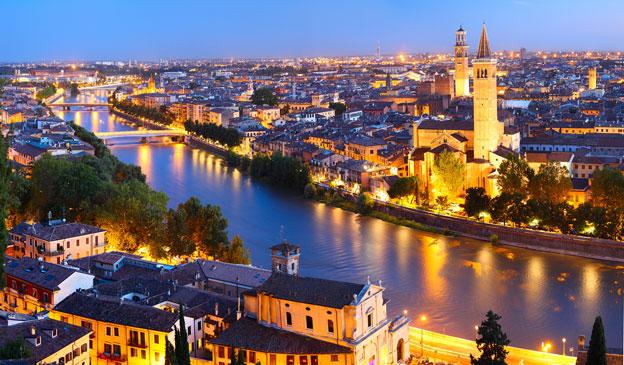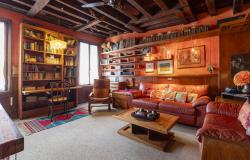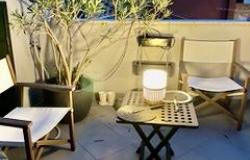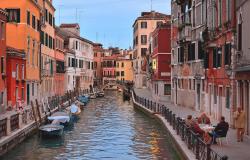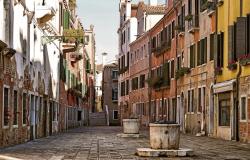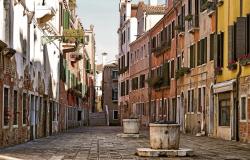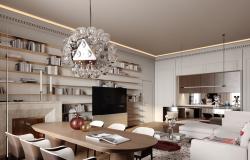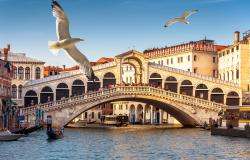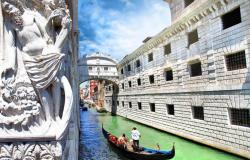Verona, now a World Heritage Site, is a great crossroads of historical periods and cultures. In the quality and preservation of its Roman antiquities, it is second only to Rome: its huge amphitheatre, its forum, theatre, bridges and monumental gateways cluster within the meanders of the River Adige and are within easy walking distance of each other. The Latin poet Catullus lived here. Its prevailing medieval structure gives Verona the fortified Castelvecchio and mixed Germanic, Byzantine and Venetian influences.
Basilicas and churches were built then, and as an antipapal stronghold it was a cultural refuge: Dante lived here for a time. The Scaligeri family who ruled for many years allowed the arts to flourish, producing the townscape that we now enjoy, full of Romanesque and Gothic structures, as well as sculptures and paintings by Pisanello and Stefan de Verona. In Renaissance times, now under Venetian rule, Mantegna had great influence, Veronese was born here and the architect Sanmicheli built palaces and other buildings.
Academies, music and sciences expanded until Napoleon arrived: for much of the 19th century the town was under Austrian domination. The wars treated Verona badly but the city centre escaped and once again in the 21st century the cultural scene is buzzing.

The best time to visit
An advantage of Verona for a weekend break is the compact centre, neatly delineated by the river and the defensive walls and gates and containing most of the places we most wanted to visit. We had no need of a car until an afternoon excursion to nearby Lake Garda.
The best way to explore the narrow streets and squares, after all, is on foot, punctuated by rest stops for espresso, gelato and lunch. We learned from the locals that we were lucky in our timing: in the summer the queues can be irritating for everyone, while in late May and early June we could afford to be spontaneous and the Veronese had time to be friendly instead of overwhelmed by numbers.
We stayed just outside the centre, and enjoyed our morning walk over the Roman Ponte Pietra, usually with a fisherman casting his line in the rapids below, entering the old town under the 13th century watch tower built during the Scaligeri dynasty.
Around a few quiet, pastel-coloured corners to our right was the Duomo, which opens onto a picturesque square of ancient buildings and balconies. The Duomo itself is an intriguing mixture of Romanesque and Gothic, built of that mixture of stone and brick that seems almost a leitmotif of Verona architecture, often giving a banded appearance to façades. Further south was the Church of Sant’Anastasia, larger and Gothic, with three naves and medieval frescoes.
The ornate Scaligeri family tombs are nearby, as well as a heady mixture of medieval churches, statues and Renaissance palaces – and we were heading for more at the Piazza delle Erbe, the old Roman Forum. That was as bustling and picturesque a piazza as we have seen in our Italian travels: the fruit and vegetable market surrounded by palaces, towers, belfries, battlements, statues, frescoes, the tall buildings of the Ghetto and the Fountain of Madonna Verona. It’s quite necessary to stop at one of the umbrella-shaded cafés to sip an espresso and take it all in! An open-minded ancient Roman of 49BC, when this colony became part of the Roman Empire, would surely approve of the use to which this fine piazza has been put over twenty centuries later.
Shakespeare brought to life

Revived, we decided on a Shakespearean diversion. Juliet’s house is just a block or so south of the Piazza delle Erbe, in the Via Cappello.
Veronese tradition is that this mellow brick 13th-century building was the house of the powerful Capulets and in the inner courtyard is the carved stone balcony so crucial to the story. The courtyard seemed small for young Romeo to stay hidden but if it had as many tall plants as there are visitors today, it could be believable. The many handwritten notes to loved ones on a section of wall are poignant, as is Costantini’s statue of Juliet in a leafy corner and the house itself gives an idea of the medieval style to which a Capulet daughter would be accustomed.
Just a few blocks away is the battlemented house identified with the Montecchi, or Montagues, but it is in poor condition and not open to the public. The remains of a Capuchin monastery south of the Arena hold the tomb attributed to Juliet and here the crypt and cloisters are mercifully peaceful and atmospheric.
We walked past the Loggia del Consiglio, the finest Renaissance building in Verona and headed down the Corso Porta Borsari to the monumental 1st-century Porto Borsari, gateway into the Roman town. Its two arches with a double row of windows above made a fitting route down Via Oberdan towards the Roman Amphitheatre, or Arena, second only to the Colosseum in Rome.
Impressive edifice

It’s the towering size of the Arena that impresses first, its rose-coloured stone and brick structure holding 44 rows of wide marble terraces capable of seating 22,000 spectators. Gladiatorial games have given way to opera during July and August. The marble is smooth, rose-pink, polished by centuries of use and, sitting there on an upper terrace, our own century and concerns get put into a different perspective, our personal lives a drop in the ocean, but one that connects down the centuries. We left with a memory of the concentric curves of terraces and arches.
The Piazza Bra next to the Arena is the largest in Verona, a spacious area where locals and tourists promenade past gardens and the Arena on one side, cafés backed by pastel palette buildings. This is another great place for people-watching: we found a table, ordered gelati,and watched the world go by.
We left indoor pursuits to the next day, still programmed by British weather patterns into making the best use of a sunny day and consulted our maps for the best route across the river to the Giusti Gardens. Our feet were beginning to tire, but these 15th/16th-century gardens, terraced to slowly uncover a view of the city below, are one of the hidden gems of Verona. Either side of a fine cypress avenue are hedges, statues, flowers, fountains and one of the oldest mazes in Europe. Mozart walked here and Fauré, Goethe, Emperor Joseph II, Cosimo De’Medici. It’s a place to linger and in April we had it nearly to ourselves.
Cultured Cuisine

We had booked dinner at the two Michelin-starred Il Desco as our weekend treat, an elegant restaurant in a restored palazzo with a 16th-century caisson ceiling, tapestries and paintings. The food is wonderfully creative, presenting beautifully the best of local produce and its wine list is extensive.
That evening we combined Verona’s history, architecture and cuisine: the menu is constantly changing but don’t miss the granita, and don’t forego the desserts.
The Castelvecchio Museum topped our list the next morning. This massive, crenellated 14th-century castle was part of the city wall structure and controlled during its time by the Venetians, the French and the Austrians as well as the veronesi. Beautifully restored and updated by architect Carlo Scarpa, it is now a delightful museum holding the city’s collections of sculpture, paintings, bronzes, frescoes, jewellery and carvings. It’s easy to spend a morning here, enjoying paintings by Mantegna, Veronese, Pisanello, Bellini, Tiepolo, Guardi and local artists.
The Romanesque church of San Lorenzo was nearby, its stone and brick banded towers providing stairs to the women’s galleries high above the nave.
That afternoon we visited the great Romanesque Basilica of San Zeno Maggiore, another of Verona’s treasures and dating mainly from the 12th century. The bas-reliefs on the portal and doors are bursting with energetic animals, stories and action and church itself with its Mantegna triptych is quite magnificent. But it’s the cloisters that appeal as well, with their slim double columns and courtyard shrine, the light shining through a small potted olive tree …
The panorama of Verona from the Giusti Gardens had been so impressive that we tried Ristorante Re Teodorico on the Piazza Castel St. Pietro, both to enjoy the view and to make our climb to the Roman Theatre all the more worthwhile. It made a perfect last evening in the city, looking down on the winding river, the towers and rooftops spread below, as the sun went down. We’ll be back, that’s for sure.
